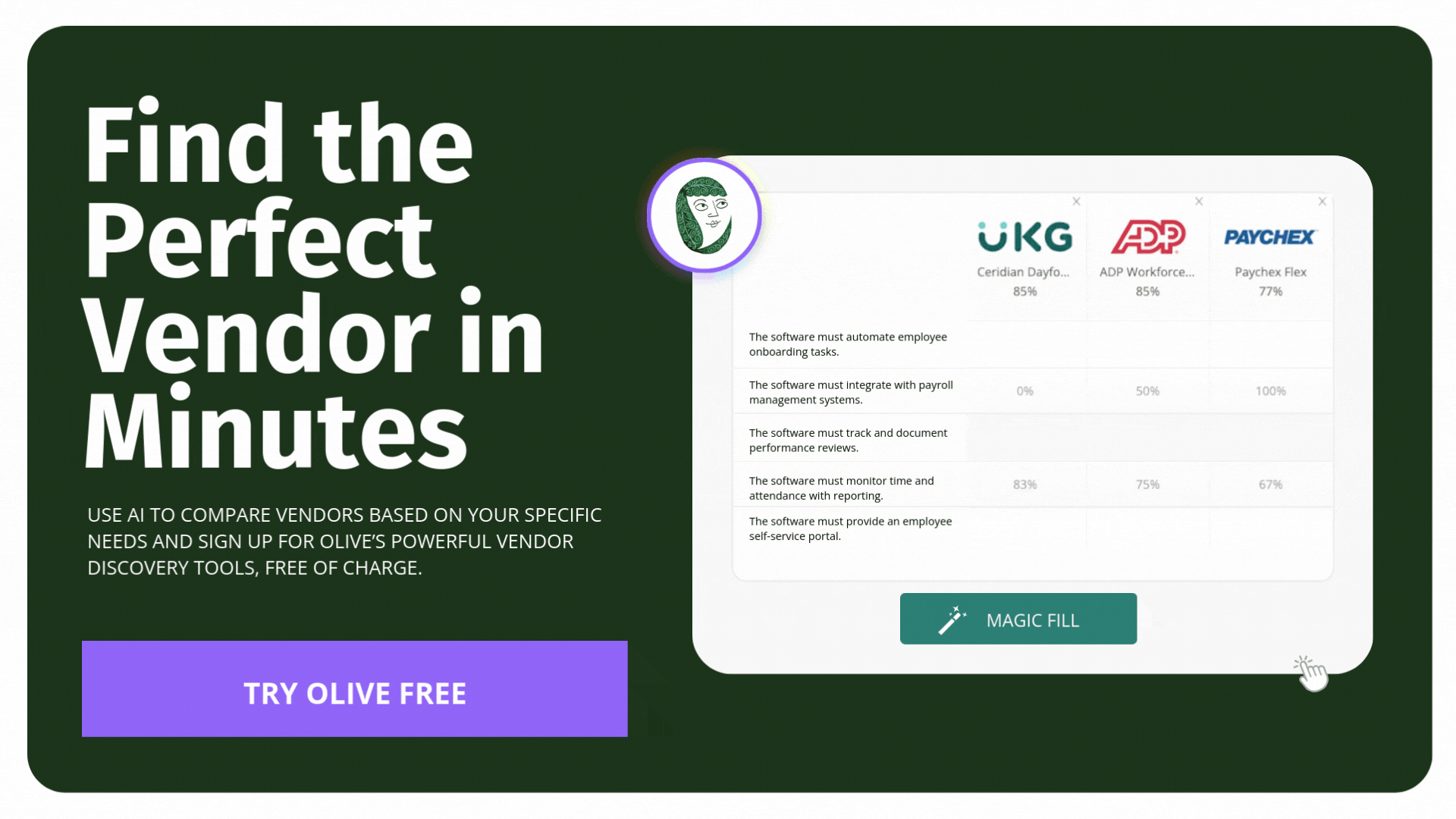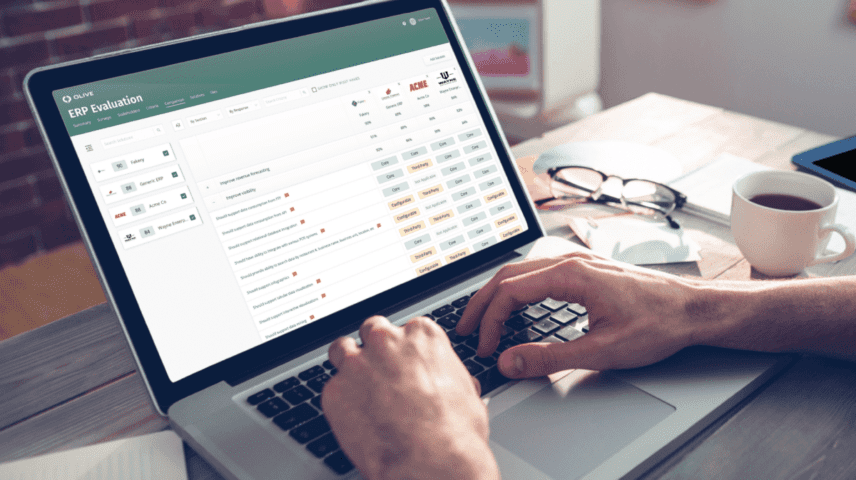You’ve spent months evaluating vendors, only to get to implementation and something goes south. Users don’t adopt it, the vendors have over-promised and under-delivered, or a crucial stakeholder was missed during the software selection process.
You’re not alone! At Olive, we constantly hear the same story about the painful software selection process. Many PMs, CIOs and consultants tell us that they all follow the same rigid and dated waterfall process; going to the big analyst sites, picking the top few solutions, then shoe-horning the one that seems to be the best fit.
The software selection process can be a daunting and often frustrating experience, with many organizations facing challenges such as poor user adoption, unmet expectations, and missed stakeholder requirements. At Olive, we understand these pain points, which is why we advocate for a different approach. Our philosophy is simple: lead with the business needs first, and leverage the power of AI to streamline the process.
Revolutionizing Software Selection with Olive’s AI
Olive’s AI powered Software Sourcing and RFP platform transforms the software selection process departing from traditional methods.
Unlike rigid processes reliant on manual evaluations, Olive leverages artificial intelligence and automation to revolutionize every stage. Analyzing vast data and user feedback, Olive’s AI identifies innovative solutions tailored to specific business needs.
This dynamic approach ensures efficiency, accuracy, and future-proof decisions, empowering enterprises to drive innovation. Olive allows organizations to confidently navigate evolving technology landscapes, staying ahead in the ever-changing digital world.
Modernizing Software Selecti£on: Beyond the Waterfall RFP Process
The traditional waterfall Request for Proposal (RFP) process is completely outdated. Once essential for custom-built systems, it now poses challenges in navigating the diverse landscape of enterprise software.
Olive’s streamlined approach acknowledges the evolution of technology and business needs. Here , we guide you through a concise and effective journey to find the ideal off-the-shelf solution for your unique requirements.
What are the Steps in the Software Selection Process?
1. Discovery – Determine a business case for the solution required
A business case ensures your company realizes measurable business benefits from the solution required. In other words, it ensures the project achieves your overarching business goals, not just the needs of certain departments, IT, Finance etc. Ensure key leaders are aligned on the business case for the new software. Describe the business challenge and assess the potential benefits the solution investment will bring to validate your need for it. Often, there are other options that could solve your problem, such as upgrading the current software or improving business processes. While a business case can validate your reasoning for a new solution it may also reveal a better course of action. Olive’s AI can analyze your business case, assess potential benefits, and validate the need for a new software solution. You gain valuable insights into the feasibility and potential outcomes, empowering you to make data-driven decisions.
2. Requirements Gathering – Understand the needs of the business
Understanding your business needs is a crucial step in the process of buying software. Ensure that the identification of these requirements is ideally a collaborative process between critical decision-makers.
Key Considerations;
- What are your business goals for the next year?
- What areas of the business are growing, and what areas are shrinking?
- How could the right solution benefit our company?
- Do we have the right budget for our needs?
- What does success mean to our business?
Answering these questions will help you determine your business needs. Ensure all stakeholders think critically about these needs. You may find during this step that a larger budget is needed. Taking the time to clearly define your business needs at this juncture will help you make a case for that. Traditionally this work is done in spreadsheets and by hosting multiple meetings. However, business needs often change over time, and even throughout the evaluation. The traditional method of ‘a moment in time RFP’ is outdated. You need to be able to pivot to your business needs, to allow for flexibility over time. Olive’s agile platform allows just that. AI-powered tools help you understand and define your business needs more effectively. Olive’s platform uses natural language processing (NLP) algorithms to analyze and categorize requirements, ensuring a comprehensive and accurate understanding. This saves time, eliminates human error, and enables collaboration among stakeholders.

2. Collaborating with the organization to define and rank your requirements list for the software
When you and your team are clear and aligned on what your business needs are, the next step is to rank and define your must-have requirements list, the non-negotiables that the software solution must have, including but not limited to;
- Cost
- Functional requirements
- Security
- Integrations with current enterprise software infrastructure
When you have defined your must-haves, you can then take a look at your nice-to-have requirements. This may include;
- User Experience
- White labeling and branding
- Mobile platform
This should be a collaborative effort amongst the team. When you begin the process, make the list as long as possible, and then rank and define the list according to needs. This ranked list will act as your guide when you begin researching options and demoing products.
When ranking this list, it’s important to consider;
- What can we afford?
- What sort of accessibility do you need the solution to have?
- Does the vendor provide an implementation plan and support?
- What are the shortcomings of the current solution?
- What technical features do we need the solution to have?
- What workflows must the new software incorporate?
- What problems should the new solution solve?

3. Build a Tailored RFP for Vendor Evaluation
Determine the ROI not only by looking at the software price vs. software value but also by initiating the Request for Proposal (RFP) process. An RFP allows you to gather detailed information from potential vendors, enabling a comprehensive evaluation of their offerings.
Recognized as a strategic tool, an RFP plays a fundamental role in extracting comprehensive information from potential vendors. This step is instrumental in facilitating a nuanced and in-depth evaluation of their capabilities. Incorporating the RFP process ensures that your organization solicits detailed and tailored responses from vendors, providing invaluable insights into their understanding of your specific business needs.
Crafting the RFP
- Prepare a detailed RFP document that includes your business goals, specific requirements, and evaluation criteria.
- Or utilize Olive to generate a comprehensive RFP, ensuring that it covers all essential aspects.

Example of Olive ERP RFP
4. Vendor Comparison
This stage of the process should be to list as many vendors as possible within your bandwidth that meet the general requirements of what you are looking for—research online for solutions in the space.
Reviews can be helpful in looking at the product from a user’s perspective. You can glean some great insights from online reviews such as what their customer support looks like or any unexpected outcomes from previous projects. Remember that on most software review websites like Capterra or g2 crowd, vendors pay to play in this space, so reviews may be biased. Another thing to consider is that these solutions may be the right choice for one industry but are not matched to your unique business needs.
Expand the vendor comparison stage to include the RFP responses. This step will help in gathering additional insights into each vendor’s capabilities.
Olive’s AI-powered vendor comparison feature evaluates and scores potential vendors based on how well they meet your requirements. By leveraging AI algorithms, Olive can recommend best-fit vendors, considering factors such as cost, functionality, security, and integrations. This data-driven approach helps you make informed decisions and shortlist vendors efficiently.
RFP Evaluation
- Assess RFP responses for how well vendors address your specific requirements and business needs.
- Leverage Olive’s AI-powered vendor comparison feature to evaluate and score RFP responses, considering factors such as cost, functionality, security, and integrations.
5. Shortlist Best-fit Solution Vendors
Now that you have your ranked requirements list, have outlined cost considerations, and researched as many vendors as you logistically can in the space – you can get to a short-list of best-fit vendors or products that will work for you using your specific business needs as the filter. Refine your shortlist based on both initial research and the evaluation of RFP responses. Eliminate vendors that do not meet the detailed criteria outlined in the RFP.
RFP-Informed Shortlisting
Consider RFP responses when shortlisting vendors, giving more weight to those who demonstrate a deep understanding of your business needs.
6. Demos and Decision-making
When you have a shortlist of 3-5 vendors who meet requirements, it’s best practice to conduct demonstrations of the potential solutions. Visit each vendor’s website to schedule yourself for a demo. This will give you a good idea of the company’s customer support. Take your time in conducting the demo, and ensure other stakeholders are demoing the product at the same time. Consider surveying users to get their feedback.
Integrate RFP insights into the demo and decision-making stage to ensure a comprehensive evaluation.
Informed Demos:
-
- Use RFP insights to tailor your demo scenarios, ensuring that vendors showcase features and functionalities directly relevant to your business requirements.
- During the demo, keep an open mind to new ideas provided by vendors, but remember to “lead with your business needs.” Do not allow vendors to take you down a road that is more aligned with their offering than your needs.
- Demoing products is considered the most important step of the software selection process, so to avoid going off track, prepare for these demos to maximize your learnings.
- Olive can streamline the demo and IT Decision Making process with AI-generated user stories and scripts guide product demonstrations, ensuring that key functionalities and use cases are covered. This helps stakeholders evaluate the software’s alignment with their business needs more effectively.
7. Select the Right Software Vendor
Based on the product demos, you will likely have a favorite. Remove bias from the decision-making process by comparing them once more to the ranked list of requirements. Do your due diligence in ensuring that you are choosing a solution based on your business’ needs and goals, without bias, with plenty of input from various stakeholders.
Put your business needs at the center of the software buying process.
Automation tools and other technology solutions are the future of business processes. Used properly, they are deployed alongside existing teams and technologies to transform and reimagine dated processes. Enterprises turning to software and technology to solve problems and future-proof their business are setting themselves up for success moving forward.
The financial, operational, regulatory, and psychological effects of COVID-19 will linger past the social distancing and isolation phases, changing the customer experience forever across various industries. The pandemic has forced many technically laggard sectors to adopt new technology and reinvest capital into digital infrastructure. Innovation can’t stop in the face of temporary adversity.
Use Olive to Run Your Software Selection Process
Sometimes, you just don’t have the internal ability, funds, or time to manage the evaluation process. That’s where investing in some help can pay off in the long run. Olive ensures that your unique business needs drive the technology purchase decisions for your company, setting you up for ROI and long-term success.
Olive takes the best process for buying business software and makes it easy for you to collaborate with your stakeholders to identify and rank your requirements. With Olive, you can anonymously look at all the solutions available in the space within the context of how these solutions meet your evolving business needs.
By harnessing the power of AI throughout the software selection process, Olive empowers organizations to make informed decisions, streamline collaboration, and ensure the chosen solution meets their business needs. With Olive as your trusted partner, you can confidently embrace digital transformation, save time, eliminate bias, and drive success. Discover how Olive’s AI-powered platform can transform your software selection journey and propel your organization into a desired future state.






